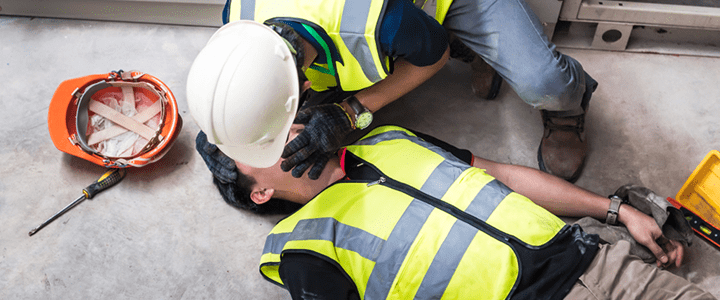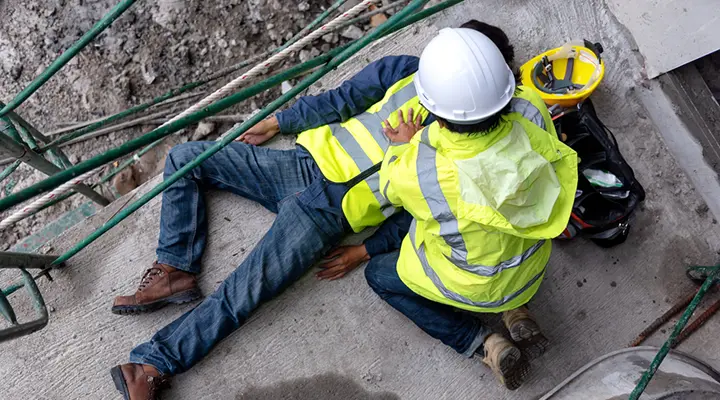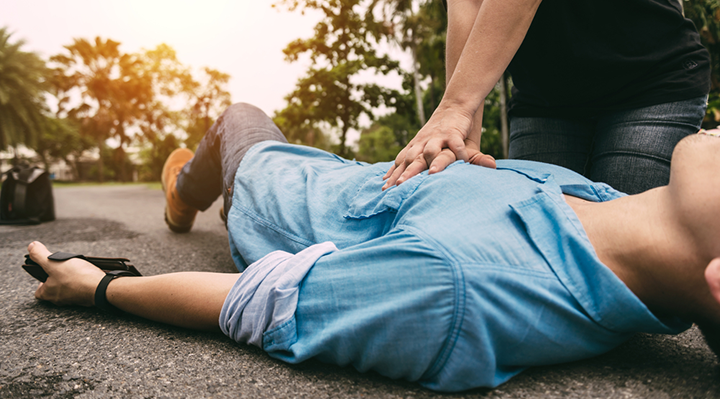CPR stands for cardiopulmonary resuscitation. It is an emergency procedure that can help to save a person’s life if they are not breathing properly (or at all) or if their heart has stopped.
When a person’s heart stops beating, they are in cardiac arrest. During cardiac arrest, the heart cannot pump blood to the rest of the body, including the brain and lungs. CPR chest compressions and rescue breaths help circulate blood and oxygen in the body. This helps keep the brain and vital organs alive until emergency services arrive. The technique used will depend on the age of casualty.
CPR Facts – Did you know?
- In the UK there are approximately 30,000 Out-of-Hospital Cardiac Arrests (OHCA) a year where NHS Ambulance Services attempt to resuscitate the victim.
- 72% of cardiac arrests occur at home and 15% occur in the workplace.
- Bystanders attempt CPR in 7 out of 10 OHCA cases and a public access defibrillator is being used in less than 1 in 10 cases of OHCA.
- Every year around 270 children die in the UK after a cardiac arrest at school.
What is a cardiac arrest?
Cardiac arrest occurs when the heart suddenly stops beating. If this happens, blood stops flowing to the brain, lungs and other vital organs. A person having a cardiac arrest can die within minutes without emergency treatment.
A person is in cardiac arrest if:
- They are unresponsive, even if you shake or shout at them
- The person is not breathing or only gasping for air
- Their heart has stopped beating and they have no pulse
What is a heart attack?
Heart attack happens when blood flow to the heart is reduced by being blocked, usually by blood clot. A person having a heart attack does not require a CPR. However, it is a medical emergency, so you should call 999 for ambulance immediately. Without urgent treatment a person may go into cardiac arrest.

How to perform CPR on an adult – Step by step
CPR Step 1: Shake and shout
If you come across a person who is unconscious, firstly check for dangers before you start helping. Ensure that you and the casualty are safe.
Shake the person gently by the shoulders and ask loudly: “Are you all right?”. If the person is unresponsive, even if you shake or shout at them, and they are not breathing or not breathing normally, they may be in cardiac arrest.
If someone is nearby, ask for help or shout loudly to attract their attention, but don’t leave the casualty alone.
CPR Step 2: Call 999
Ask someone to call 999 immediately for an ambulance or, if there is no one around, call 999 before starting compressions.
Then, ask someone to find an AED (automated external defibrillator) if possible. This is a medical device that analyses the heart’s rhythm and sends an electric shock to the heart to restore normal rhythm when a casualty is in a cardiac arrest.
CPR Step 3: Give chest compressions
To carry out a chest compression:
- Kneel next to the person.
- Place the heel of one of your hands on the breastbone in the centre of their chest. Place your other hand on top of the first hand and interlock your fingers.
- Position yourself so your shoulders are directly above your hands. Using your body weight (not just your arms), press straight down by 5 to 6cm (2 to 2.5 inches) on their chest.
- Release the pressure without removing your hands from their chest and allow their chest to return to its original position.
- Repeat these compressions at a rate of 100 to 120 times a minute – that’s around 2 per second.
CPR Step 4: Give rescue breaths
If you are able, combine chest compressions with rescue breaths. After every 30 chest compressions, give 2 rescue breaths. If you are unable to give rescue breaths, give chest-compression-only CPR. Compression-only CPR is the same as usual CPR but without rescue breaths. You need to perform chest compressions continuously until emergency help arrives.
To carry out a rescue breath:
- Check that the casualty’s airway is open before giving the first rescue breath – tilt the person’s head gently and lift the chin up with 2 fingers.
- Pinch the person’s nose, so it is firmly closed.
- Take a normal breath and seal your mouth over their mouth. Then, blow steadily and firmly into their mouth for about 1 second. Check that their chest rises. Give 2 rescue breaths.
- Continue with cycles of 30 chest compressions and 2 rescue breaths.
Step 5 of CPR: Keep going
Continue giving CPR until help arrives or the casualty starts showing signs of consciousness – starts coughing, opening their eyes, breathing normally or speaking. If the person regains consciousness, stop CPR and put them in the recovery position.
If you are getting tired, and there’s someone nearby to help, ask them to take over giving CPR. You can show them what to do and take turns until emergency help arrives.
Step 6 of CPR: Use a defibrillator (AED)
As soon as an AED arrives, switch it on and attach the pads to the casualty’s chest.
You do not require training to use an AED. They are designed for use by the general public, and they provide visual and audio instructions when you operate them.
Follow the AED instructions until an emergency responder arrives and can take over, or place the casualty in the recovery position if they start to breath normally.
How to perform CPR on an child (over 1 year) – Step by step
CPR Step 1: Tap and shout
Before approaching the child, ensure that the area is safe.
Use a loud voice to ask a child to open their eyes. Then, place one hand on their shoulder and tap gently. If there is no response, and they are not breathing, you will need to start CPR.
If there is anyone nearby, shout loudly to attract their attention and ask for help. Do not leave the child.
CPR Step 2: Call 999
Ask a helper to call 999 immediately for emergency help and to bring a defibrillator (AED). Do not leave a child to make a call or to look for an AED.
CPR Step 3: Give initial rescue breaths
To carry out a rescue breath:
- Check that the child’s airway is open before giving the first rescue breath – place one hand on their forehead, gently tilt their head back and lift the chin. Then, check that their mouth and throat is clear, and remove any obvious obstructions from their mouth and nose.
- Take the hand from the forehead and pinch their nose.
- Take a normal breath and seal your mouth over their mouth.
- With their head tilted, blow into their mouth gently and steadily for about 1 second, until their chest rises.
- Remove your mouth and watch their chest fall.
- You need to give 5 of these rescue breaths.
CPR Step 4: Give chest compressions
To carry out a chest compression:
- Kneel next to the child.
- Place the heel of one of your hands on the centre of the child’s chest near the end of the breastbone, but keep your fingers off the ribs.
- Push down by 5cm, which is about one-third of the depth of the chest.
- Release the pressure without removing your hands from their chest and allow their chest to come back up.
- Give 30 compressions at a rate of 100 to 120 times a minute (2 per second).
Step 5 of CPR: Give rescue breaths
After the 30 compressions, open their airway and give 2 more breaths.
Keep going with 30 chest compressions and 2 rescue breaths.
Continue CPR until emergency help arrives or the child shows signs of consciousness (breathing, opening eyes, moving).
Step 6 of CPR: Use a defibrillator (AED)
As soon as the helper brings an AED, ask them to switch it on and attach the pads to the child’s chest.
Continue performing CPR while the helper sets the AED up. Then, follow the voice prompts given by AED.
If a child starts showing signs of consciousness, put them in the recovery position and be prepared to give CPR again if necessary.
How to perform CPR on a baby (under 1 year) – Step by step
CPR Step 1: Tap and shout
Before approaching the baby, check for any dangers and ensure that the area is safe.
Call their name and gently tap the bottom of their foot to see if they respond. If there is no response, and the baby is not breathing, you will need to start CPR.
Shout loudly to attract others attention and ask for help. Do not leave the baby alone.
CPR Step 2: Call 999
Ask a helper to call ambulance immediately and to bring a defibrillator (AED). If there is no one around, call 999 before starting compressions. Do not leave the baby.
CPR Step 3: Give initial rescue breaths
To carry out a rescue breath:
- Open baby’s airway by placing one hand on their forehead and very gently tilting their head back. Use other hand’s fingertip to gently lift their chin.
- Take a breath and seal your mouth over baby’s mouth and nose.
- With their head tilted, blow gently and steadily for about 1 second, until their chest rises.
- Remove your mouth and watch their chest fall.
- Give 5 of these rescue breaths.
CPR Step 4: Give chest compressions
To carry out a chest compression:
- Place 2 fingers in the centre of the baby’s chest and push down a third of the depth of the chest. That is approximately 4 cm.
- Pinch the person’s nose, so it is firmly closed.
- Release the pressure without removing your fingertips from the baby’s chest and allow their chest to come back up.
- Give 30 compressions at a rate of 100 to 120 times a minute (2 per second).
CPR Step 5: Give rescue breaths
After the 30 compressions, open their airway and give 2 rescue breaths.
Keep going with 30 chest compressions and 2 rescue breaths.
Continue CPR until emergency help arrives or the baby shows signs of consciousness (breathing, opening eyes, moving).
If the baby shows signs of consciousness, put them in the recovery position and prepare to give CPR again if necessary.
Step 6 of CPR: Use a defibrillator (AED)
AEDs are safe to use on babies. As soon as the helper brings an AED, ask them to switch it on and attach the one pad to the baby’s chest and one pad on the baby’s back.
Continue performing CPR while the helper sets the AED up. Then, follow the voice prompts given by AED.
If a baby starts showing signs of consciousness, put them in the recovery position, leaving the AED attached. Be prepared to give CPR again if necessary.

How many chest compressions should be given in CPR?
The number of chest compressions will depend on whether you perform CPR with rescue breaths or hands-only CPR.
Early in the pandemic, The Resuscitation Council UK updated CPR guidelines to reduce the chances of Covid-19 transmission when performing CPR. They recommended doing hands-only CPR.
CPR with rescue breaths:
Repeat sets of 30 chest compressions (at a rate of 100 to 120 per minute – 2 per second) and 2 rescue breaths until a person regains consciousness or professional help arrives.
Hands-only CPR:
Perform chest compressions continuously (at a rate of 100 to 120 per minute – 2 per second) until a person regains consciousness or emergency help arrives.
How deep should chest compressions be?
While giving chest compressions to adults, you should press down the chest down by 5 or 6 cm. If you are performing chest compressions on a child (over 1 year old), push down their chest by 5 cm. To give chest compressions to a baby (under 1 year old), push their chest down by 4 cm, which is approximately one-third of the chest diameter.
5 situations when you do not perform CPR
You should stop performing CPR when:
- A person regains consciousness, and you see an obvious sign of life – they start breathing normally, coughing, opening their eyes, moving or speaking. You can then put them in the recovery position. Be prepared to give CPR again if necessary.
- An AED (automated external defibrillator) is available and ready to use. It should be set up as soon as it is available. This may require you to stop CPR momentarily to apply the defibrillator if you are on your own. Once the AED has been set up, you should follow the voice prompts. It may ask you to resume CPR.
- You are too exhausted to continue. If there is someone nearby, ask them to take over giving CPR or, if you are on your own and can no longer continue due to fatigue, you can stop giving compressions.
- Emergency responder arrives. You should then follow the instructions of medical professionals.
- The scene becomes unsafe. If the area or situation becomes too dangerous, you should try to move the casualty to a safer place and resume CPR. However, if the situation is too dangerous and you cannot move the person to safety, you should stop CPR and preserve your own life.
Looking for a First Aid in the Workplace Training course?
First aid in the workplace training gives employees the confidence and ability to react immediately to an illness or injury, before emergency help arrives. Reacting quickly to an illness or injury, can reduce recovery time and mean less impact on the business.
Statistics show that staff trained in first aid learn to be more conscious of safety in the workplace, leading to a reduced number of accidents and injuries.
If there is an emergency in the workplace, simple first aid can be life-saving. Everyone should consider taking a first aid course.
We offer the following online RoSPA-assured and CPD-certified course:
Online First Aid in the Workplace Training

Any further questions?
If you have any questions regarding our first aid training course our team is always ready to assist. You can contact us on 0333 5775 017, email us at support@i2comply.com or complete our enquiries form.



